Warning: Undefined variable $k in /home/nginx/domains/wired2fishcom.bigscoots-staging.com/public/wp-content/themes/understrap-child-0.6.0/functions.php on line 984
Warning: Undefined variable $k in /home/nginx/domains/wired2fishcom.bigscoots-staging.com/public/wp-content/themes/understrap-child-0.6.0/functions.php on line 987
Of all our favorite gamefish, catfish require the widest array of fishing rigs in order to catch them in the many places they are found. One key reason is that the best baits for catfish are far more diverse than for bass, muskies, walleyes or trout. One day, we might use little chunks of chicken liver to catch some nice channel cats out of a creek. The next week, we might be setting out a live 3/4-pound brown bullhead to lure a 50-pound flathead catfish from his snaggy lair.
To effectively make the best of these differing baits, we need the right combination of line, hook, sinker and sometimes a few extra accessories that can help accomplish the task. Although catfish species can be choosy about where they live and what they eat, they’re usually not fussy about the particulars of a rig, as long as it gets the bait in the right place and can haul the fish back out. For example, bass guys carefully thread their Texas rigs so the bait hangs straight and the hook is tucked neatly into the bait.
Catfish couldn’t care less if a bait is sideways or upside down. And the point of a hook sticking out doesn’t phase them at all. They operate primarily by senses of smell and taste, and they’re used to eating tough stuff, such a spiny bluegills, mussels and big-clawed crawfish.
As a result, we like to make our rigs as simple as possible, with fewer components that can interfere with a natural looking presentation. For some pond fishing, just a hook and a chunk of stinkbait can do the trick. Tie it on, and you’re set. But in most waters, weight is needed to get the offering down into the feeding zone, and longer casts may be required.
In small impoundments, a pinch-on weight or a few split shot are sufficient to get baits out where catfish feed. But in a big tailrace, you might need a 6-ounce bank sinker to bomb a cut bait out into the sweet spot below a dam.
No single type of rig works for all situations, since catfish inhabit diverse waters, so there are many ways to set out baits for the best bite.
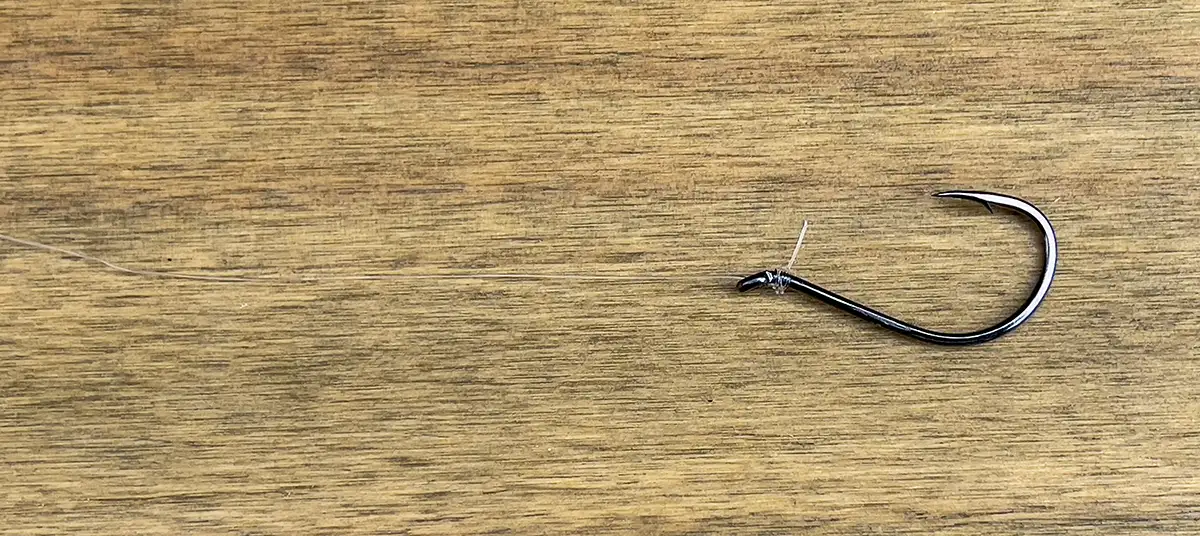
FREE LINING RIG
In slow creeks and small lakes, you can get a good natural presentation with no weight at all. Cast out to the offshore zone and let the bait’s attractive scents bring fish to you. In a shallow stream, current slowly pulls the bait downstream, so keep releasing line as it drifts naturally.
Reel in and cast again, or else set the hook when one eats it. This setup can be hassle when a stream or lake has a lot of snags, however. Wind is another enemy of unweighted rigs, as it can limit casting distance or blow your line and bait out of position.
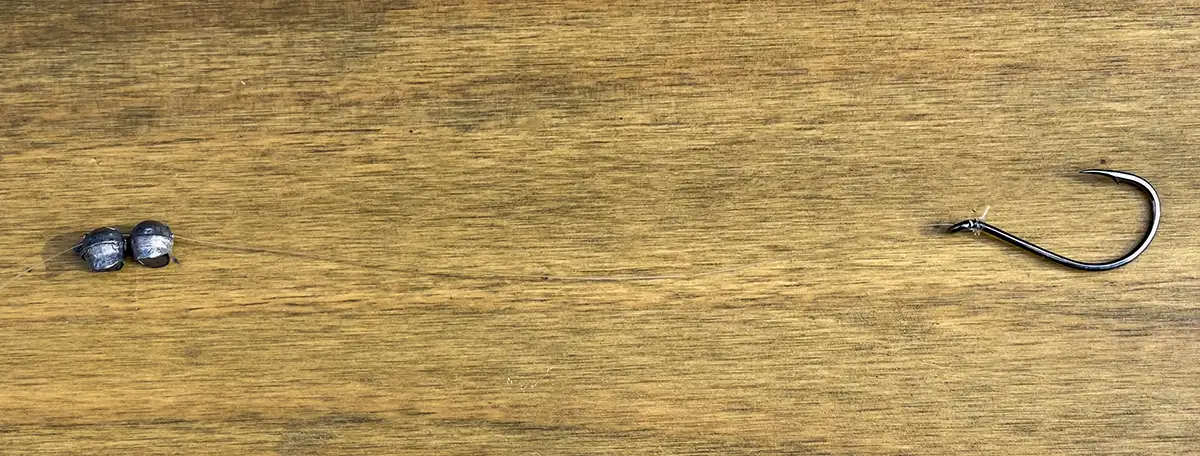
SPLIT-SHOT RIGS
When current, wind, or depth make an unweighted rig impractical, adding a few split shot is a simple solution. This setup works well for bank-fishing in lakes and reservoirs. If you have to cast farther to reach good water, beef up with a few No. 7 shot that can carry a chunk of bait out 30 yards.
Use only as much weight as you need. While catfish can be greedy feeders, at times, an unnatural amount of weight can make them drop it. Like all other fish, catfish are more active and aggressive on some days than others, due to many factors. So yo have to read the bite and react by adjusting your rig.
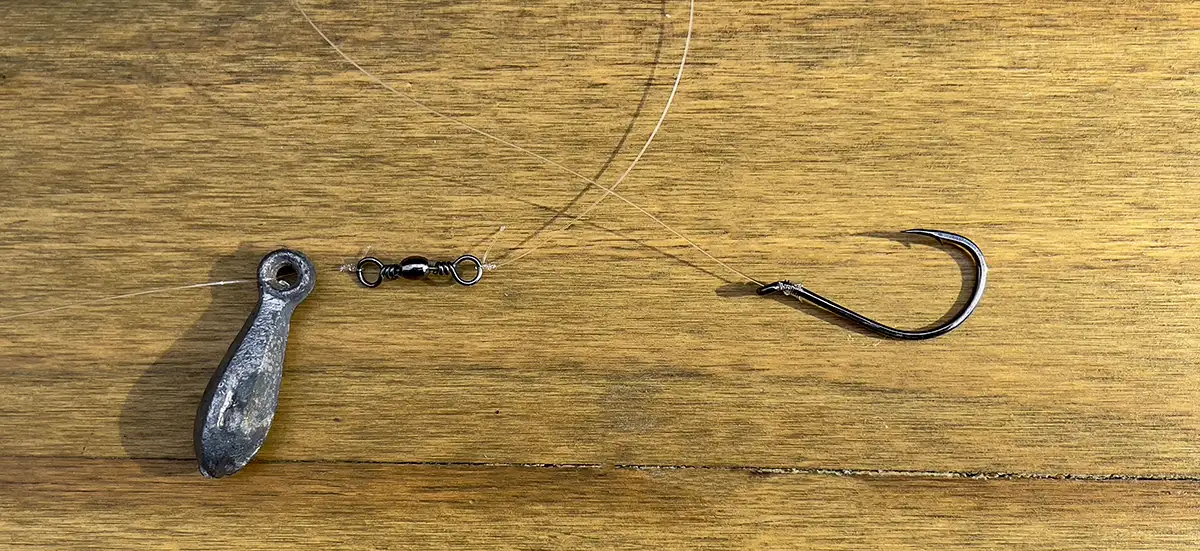
SLIP RIGGING
Many sinker styles allow the fish to pick up your bait without sensing pressure, so slip rigs, which operate similar to Carolina rigs used in bass fishing, are very effective and popular in many situations. The line slips through the weight so you can set the hook when you’re ready.
Note that catfish often swallow small baits quickly so quick hooksets often work best and avoid gut-hooking. Just wait a couple seconds for the fish to turn with the bait in its mouth, set, and you’ve got ‘em!
The simplest rig for catching catfish consists of an egg sinker separated from the hook and bait by a few inches with a split shot or a barrel swivel. These weights come in sizes from just 3/8 ounce on up to half a pound.
While egg sinkers work in calm water or the cast directly behind an anchored boat, their shape allows them to roll in current. When cast into a river, they can roll downstream and snag the hook on whatever’s on the bottom.
In such situations, bell sinkers with a swivel through the top tend to hold bottom better since they stand up. In stronger current, flattened “no-roll” sinkers work well, holding on bottom with their large surface area and weight, with a hold through the middle for line to slip.
In the snaggiest conditions, whether it’s rock or timber, slinky-style sinkers help keep you out of trouble. Set these long and slightly curved weights above a swivel and bead to prevent line twist. These weights glide through tangles that would destroy egg or bell sinkers.
Some are solid, such as the Lindy No-Snagg weights, while others are made of heavy tubular canvas with split shot inside. Though they weigh several ounces, they dance through snags.
Unlike walleye fishing, short leaders are best for catfish slip rigs, just 2 to 6 inches on most cases. Catfish aren’t spooked by a sinker on the bottom. Moreover, a longer length line tends to move around wildly in current, making it more likely to snag on bottom or flip back and foul on your main line. In still waters, foot-long leaders work fine, however.
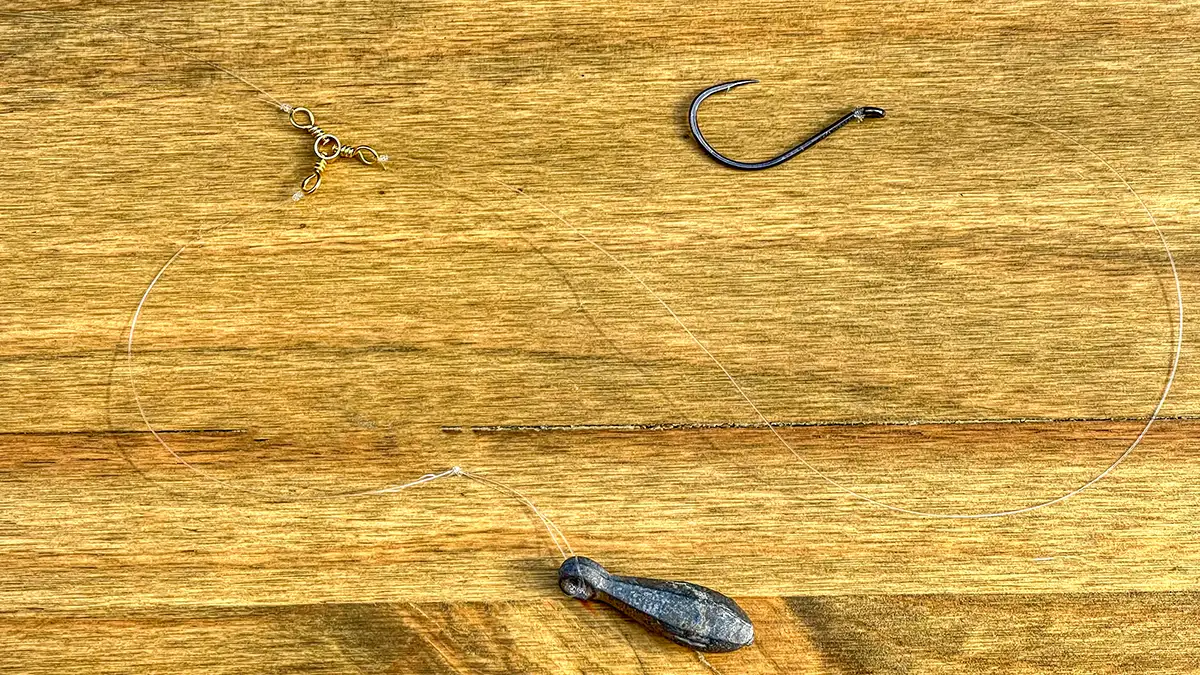
THREE-WAY RIG
The three-way rig is a little more complicated but very effective in deeper reservoirs and rivers. You can use it to fish bottom in both flat water and current, but it really shines for drifting down big rivers such as the Mississippi, Tennessee, or Ohio where key spots may be more than 30 feet deep. It’s also a top rig when you wind-drift across wide reservoir flats to find fish.
It starts with a strong three-way swivel with a dropper line off one eye that can range from 6 to 30 inches, depending on how far off bottom you want your bait. Your leader line comes off the other eye of the swivel, often 2 to 4 feet long with a hook on the end.
Some anglers use stronger line on the leader to prevent break-offs from big fish with tiny teeth than can quickly saw through 30-pound line. The swivel helps to keep the three lines from twisting and tangling, a common problem in river fishing.
BOTTOM-BOUNCER RIG
Take a page from the walleye fisherman when drifting baits in big rivers by using a bottom bouncer. These simple devices are wire, with a shorter arm to tie your line and hook, and a longer arm with a big lead weight in the middle.
The bottom wire keeps baits just off the bottom and avoids snags, as the wire causes the rig to bounce over objects like a pole vault. You can also slow-troll these rigs across reservoir flats to cover water and locate groups of catfish of all species.
CATFISH JIG RIG
When you use a very short leader on a slip sinker rig, you’re just one step away from using a jig to hold your bait. They’re not commonly used but can be useful in several situations. Without a leader, you’re in direct contact with the hook and bait, so bites are more easily detected.
Though jigs add some weight to the package, it’s rarely a detriment to getting bites, as channel catfish are generally very eager eaters. They usually don’t nibble at a bait, except in the dead of winter, but quickly suck it up and move off to swallow.
At times, flatheads mouth big live baits, maneuvering them around in their huge mouths to position the fish for easiest swallowing, so slip rigs generally work best for them. But especially in current, cats are not deterred by an extra ounce of weight on their meal, any more than they care about chomping down on a sharp hook.
The advantage of using a jig is better casting accuracy, as well as enhanced sense of feel and ability to hop the bait off bottom, allowing it to drift a few feet downstream. Threading a shiner or small sunfish on a jig makes a fine package, and light ball-head jigs work well with cut bait and chicken livers in shallower reservoirs and rivers.
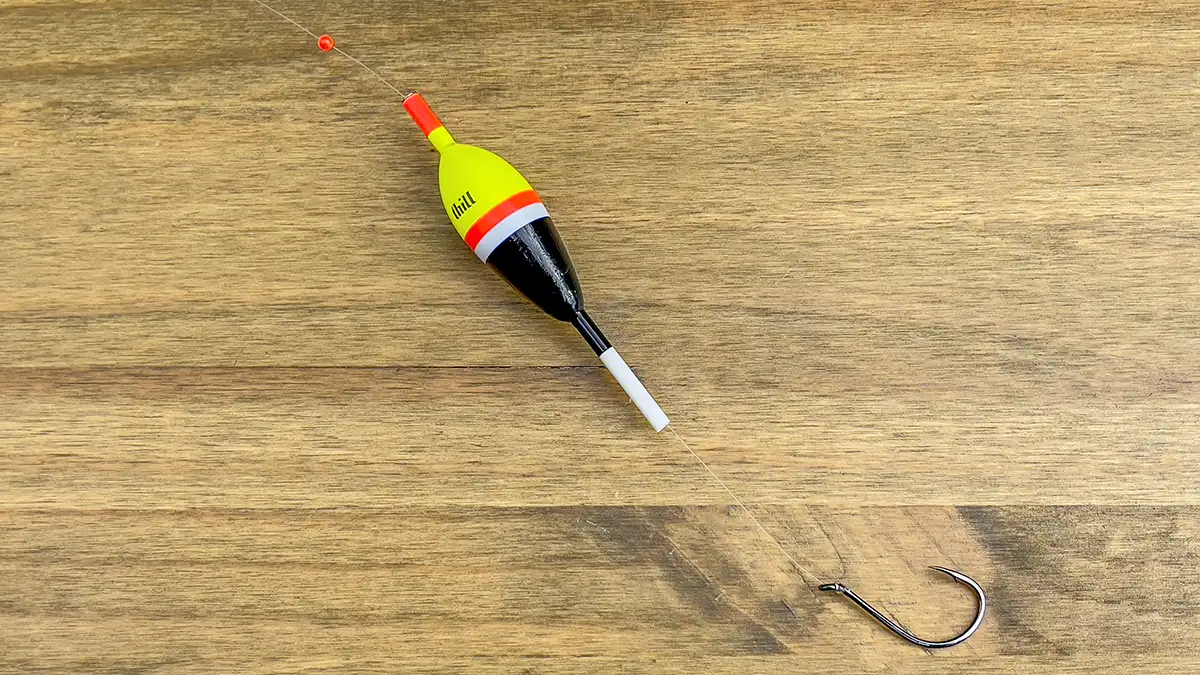
FLOAT RIGS
A float set above your bait serves a couple of purposes: it’s a strike indicator, so when it goes under, set the hook! Floats or bobbers are also very helpful in river situations to keep your bait just above bottom where there are a lot of snags. Catfish nearby can smell the bait moving downstream and are ready to open their mouth and eat it or swim upward to bite.
Using a float also allows you to cover a lot of water whether you’re casting offshore or fishing from a boat anchored in a river, which is a great place for using floats.
Pick a float that’s big and buoyant enough to hold your bait and your weight up off bottom. Some folks like weighted pole floats that are 8 or 10 inches in height for tailrace fishing, for their buoyancy and the way they can be seen at a distance.
A slip float is your basic tool, as the line slides through it. Before tying on your hook, set a stop-knot or neoprene bead on your line, then thread the line through the float, tying on the hook, and sliding a sinker on a leader set for the depth of water you’re fishing. Set the weight about a foot above the hook to give it a little space.
With a slip float, it’s simple to adjust depth when you move from spot to spot. With the float and rig drifting, you can keep releasing line from the reel to allow it to move farther downstream in current. Don’t let it get too far downstream or you may miss bites or be unable to get a good hookset when a fish takes it.
Big floats excel for catching big blue cats and flatheads from the bank in reservoirs. Setting out big live baits under a float accounts for many huge flatheads for night fishermen. The big ones move out of thick cover after dark and hunt, and they’re willing to swim well off bottom to eat a scrumptious carp, sunfish, or bullhead as limb-line fishermen know.
Blue cats are not as nocturnal, and they move shallow in spring in search of shad and other prey, and floats allow you to probe large flats to find active fish. In some waters, the bottom becomes coated with thin vegetation or algae so set the float to hold the bait just above it.
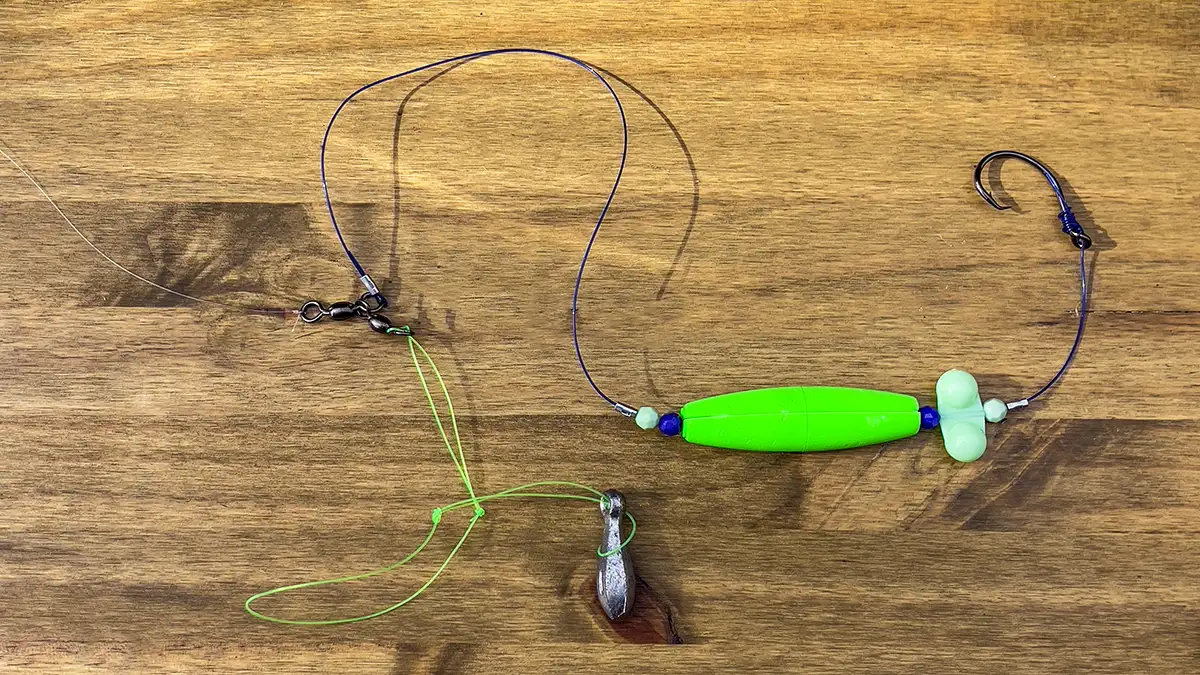
SANTEE RIG
You can take a few of these rigs and combined them to make a fairly newer rig called the Santee Rig. A Santee Rig consist of either a slip rig or a three way rig, with the minor difference that the dropper line with the hook also has a float to keep the bait up off the bottom more. A lot of savvy catfish anglers also use rattling bobber, rattle clips or even old topwater lures with rattles as their float as an added attraction to help the catfish find the rigged bait in current and/or dark, muddy waters.
The float is usually a slip float inline or a you can also tie to the nose of a topwater pencil bait and then tie the hook to the back of it on a dropper line. And some good tackle shops sell pre-made Santee Rigs that you just tie to your main line via a swivel.
This rig is handy when you want your rigged bait to get up above cover, rocks, or debris on the bottom that might obscure your bait from the catfish.
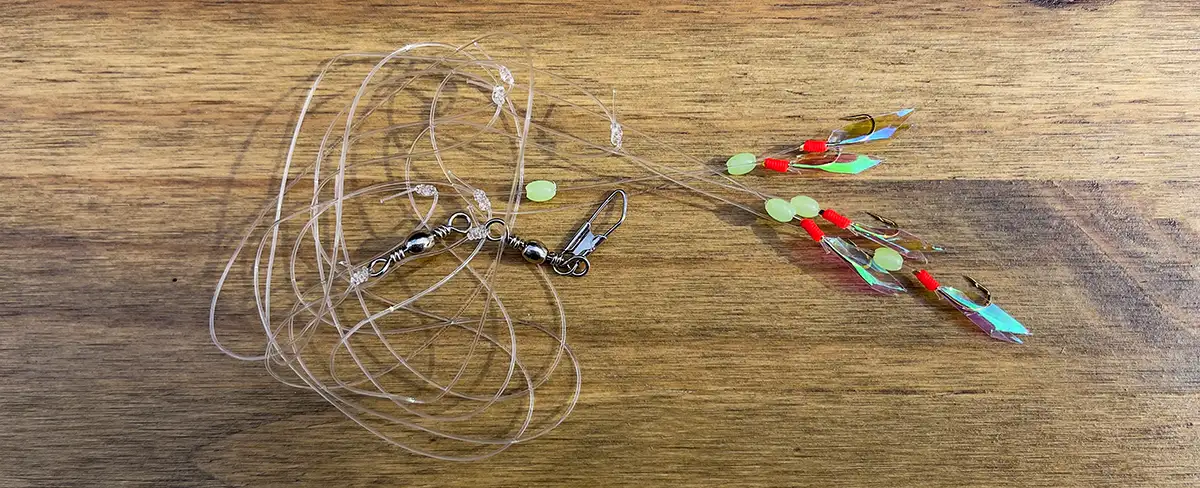
SABIKI RIGS FOR CATCHING CATFISH BAIT
If you’re wanting to cut up herring, shad, skip jack or other types of baitfish for use in catfishing, and you don’t have a cast net or are not adept at casting a cast net, then a sabiki rig is another way to catch bait. Basically you tie the swivel to your mainline, and put a weight at the bottom of the rig, and the mylar flash on the hooks looks like tiny bugs or baitfish for bigger baitfish to feed on. This is a popular rig when fishing below dams, and around bridges for catching bait in a pinch. So as a catfish angler, it’s worth having a small spinning rod and reel setup to drop and catch bait when needed.
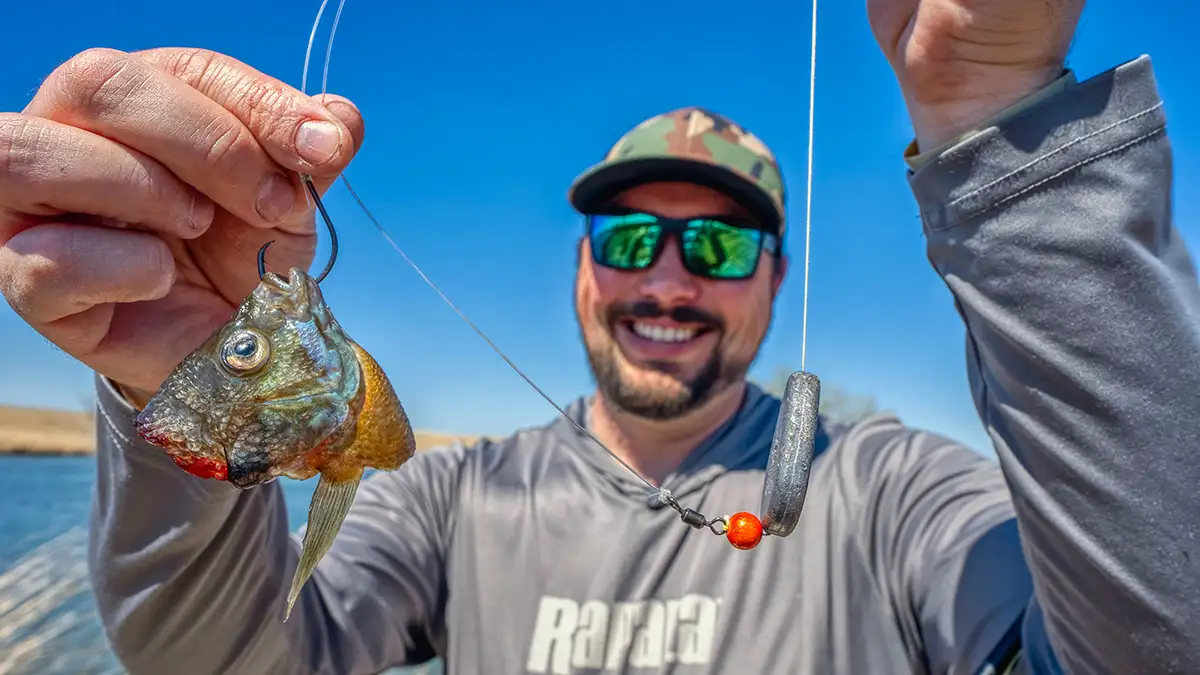
BEST RIGS FOR BANK FISHING
A slip rig is probably the most popular for bank fishing, as well as a float rig. However, it mostly depends on where you plan to fish. If you’re fishing on a bank of rip rap say near a dam or bridge, you might want to fish a float rig or split shot rig so your weight doesn’t bury into the crevices and get stuck. If you’re fishing on a river and have current and a fairly smooth bottom, a 3-way rig might be best. If it’s a slackwater area, a slip rig or float rig is probably the best bet as well as a free rig.
Match your rig to the current, cover and depth accordingly when fishing from the bank for catfish.
RECOMMENDED TERMINAL TACKLE FOR CATFISH RIGS
Here is a quick rundown of the terminal tackle we recommend for these various catfish rigs:
- Circle Hooks (Buy Here)
- No. 5-7 Split Shot (Buy Here)
- Bank Sinkers (Buy Here)
- Lindy No-Snagg Sinkers (Buy Here)
- Barrel Swivels (Buy Here)
- 3-Way Swivels (Buy Here)
- Floats (Buy Here)
- Santee Rig (Buy Here)
You also might want to check out our guide on the best catfish hooks.
CATFISH RIG WRAP-UP
As in bass fishing, tournament catfish anglers get familiar with the advantages of all these rigs and how they can work in contest waters across many states. Catfish anglers who stay closer to home get used to their favorite rigs that work well in local waters.
Either way, anglers can make minor adjustments in sinkers, hooks, leaders, floats and more to achieve the best results. Whatever setup puts the bait where the fish are, lets you hook them efficiently, and doesn’t snag too much is fine.












